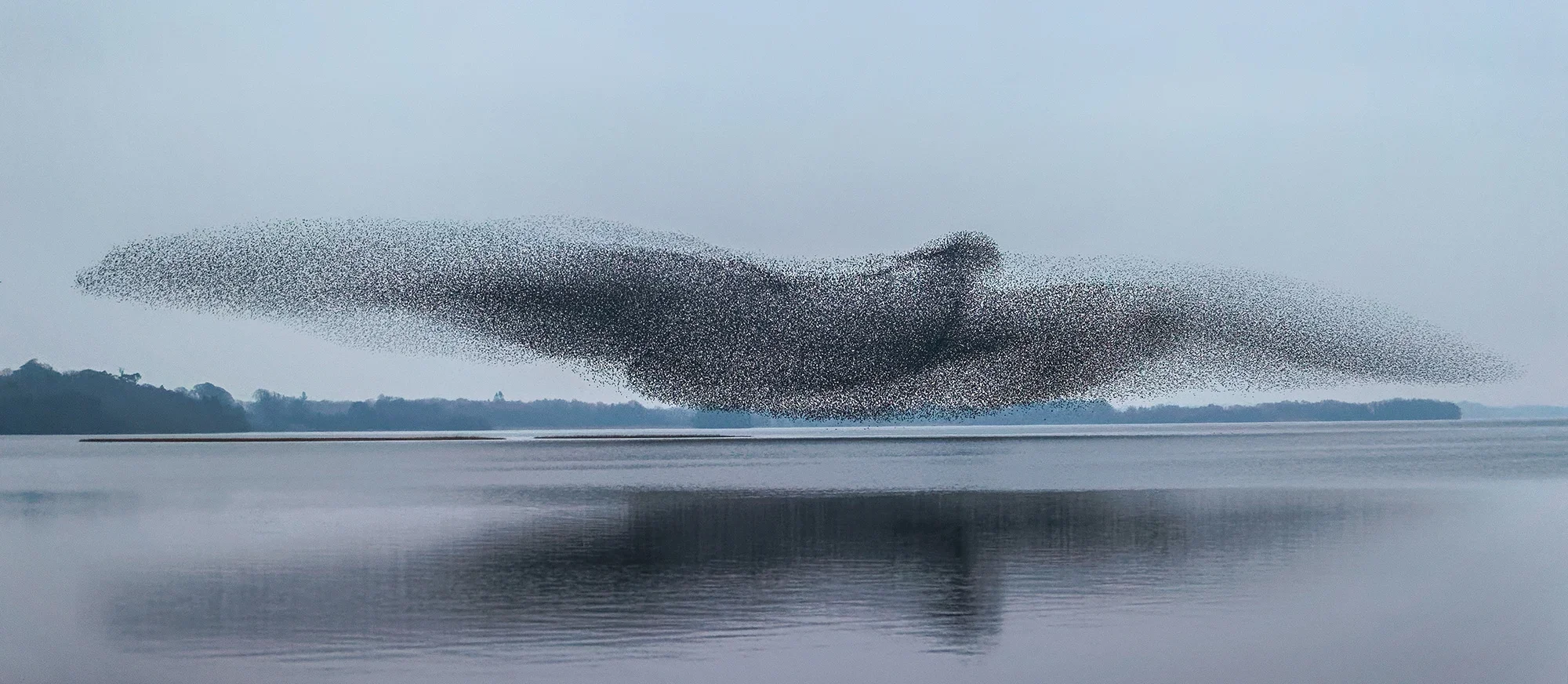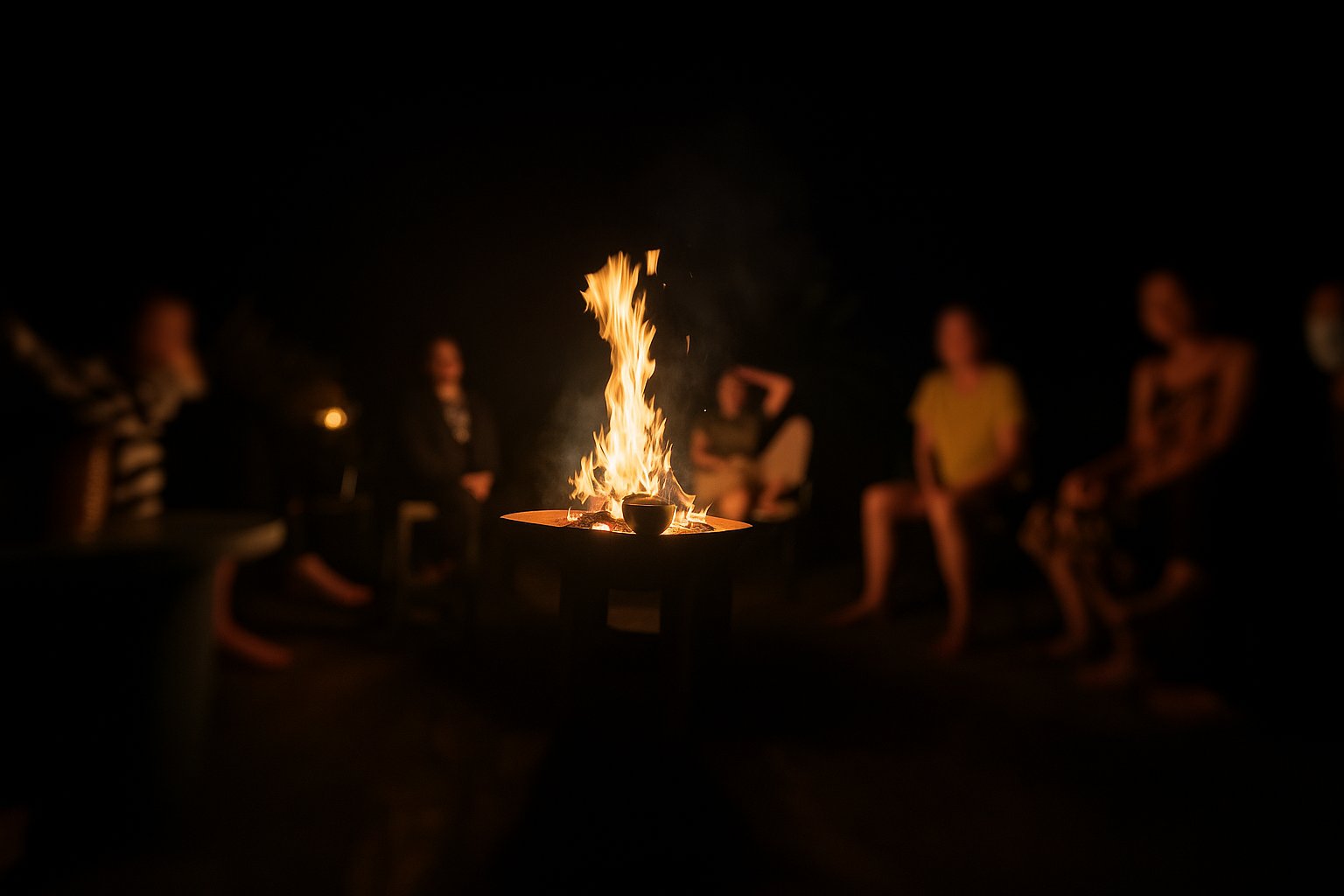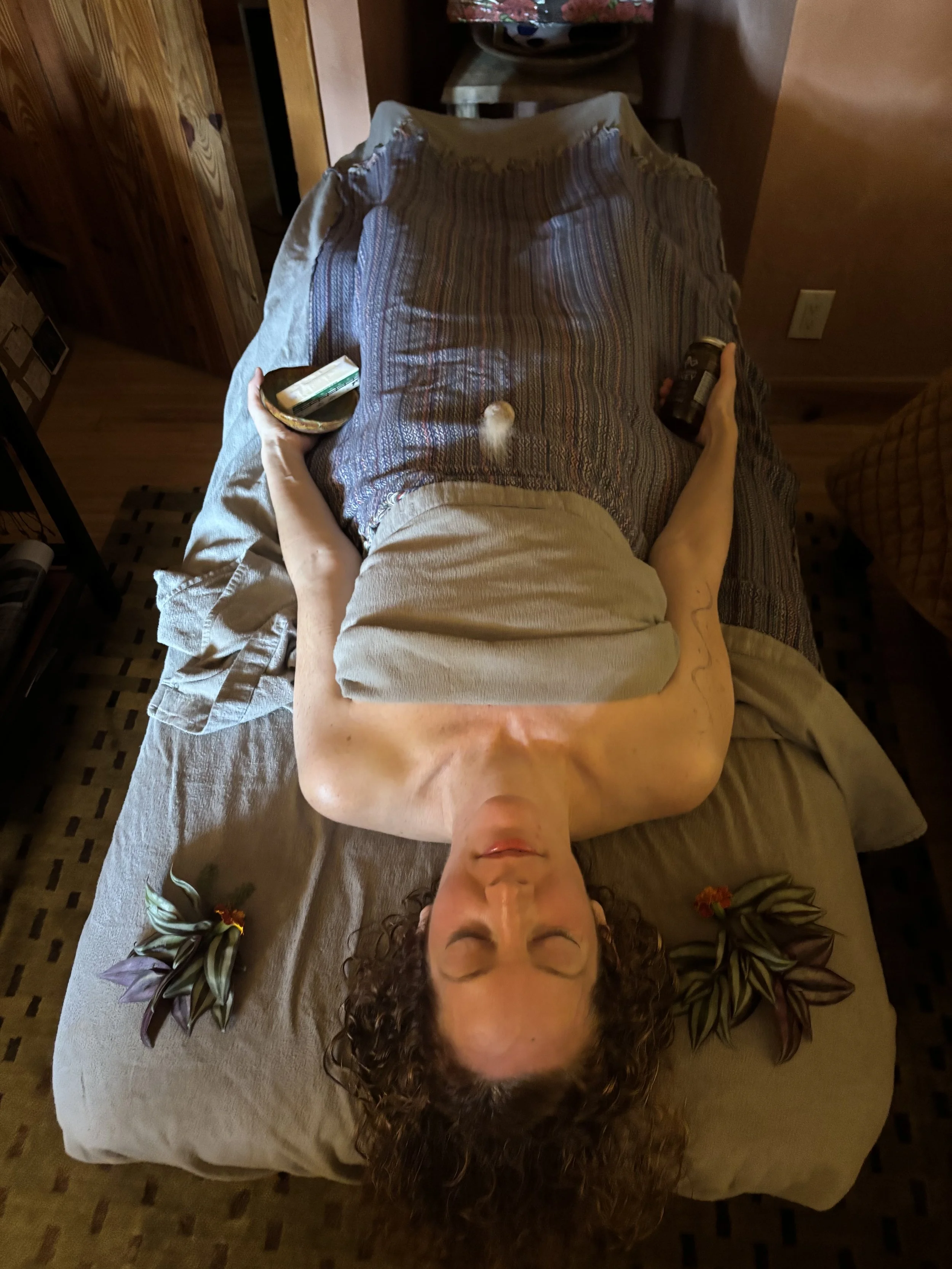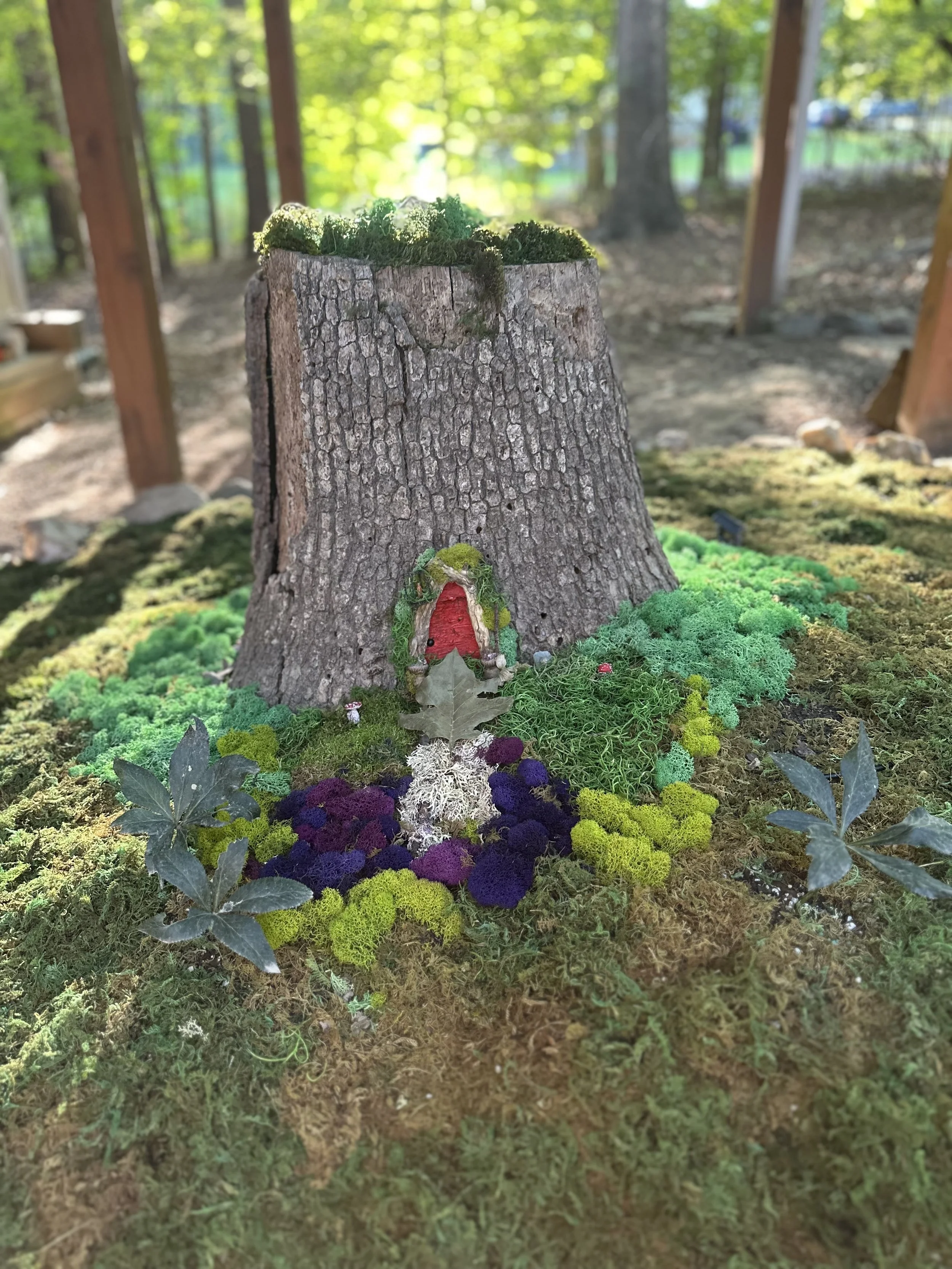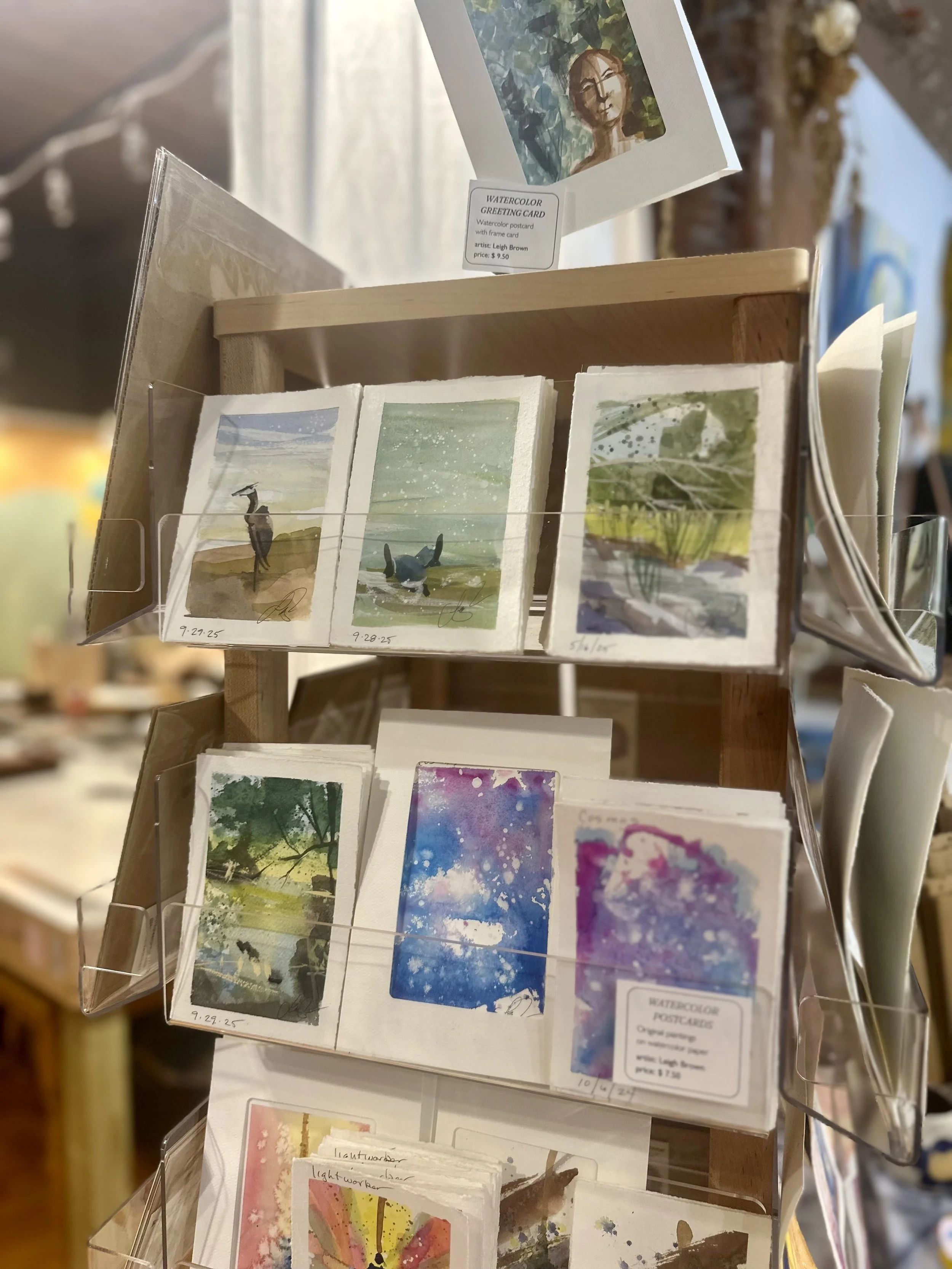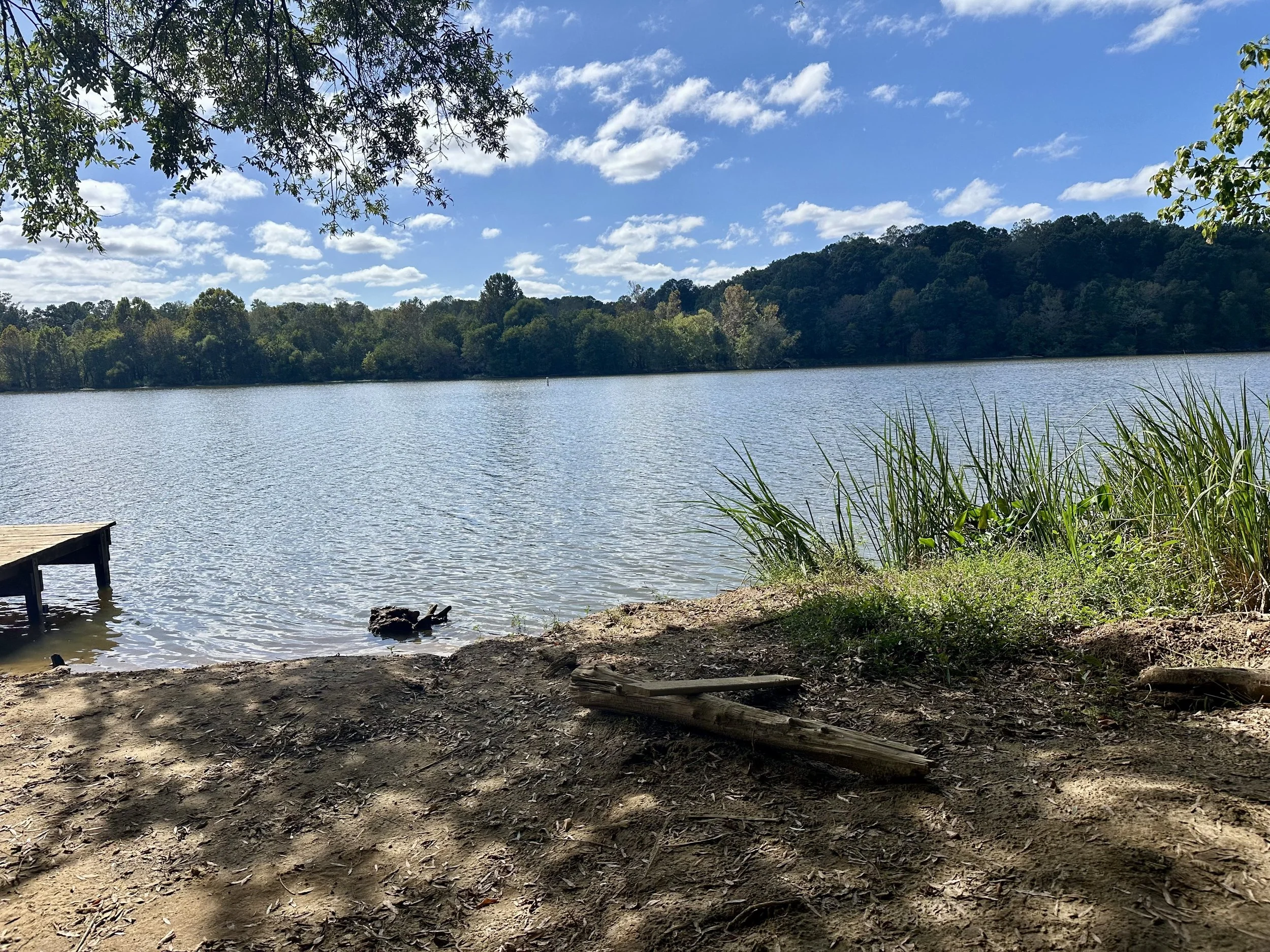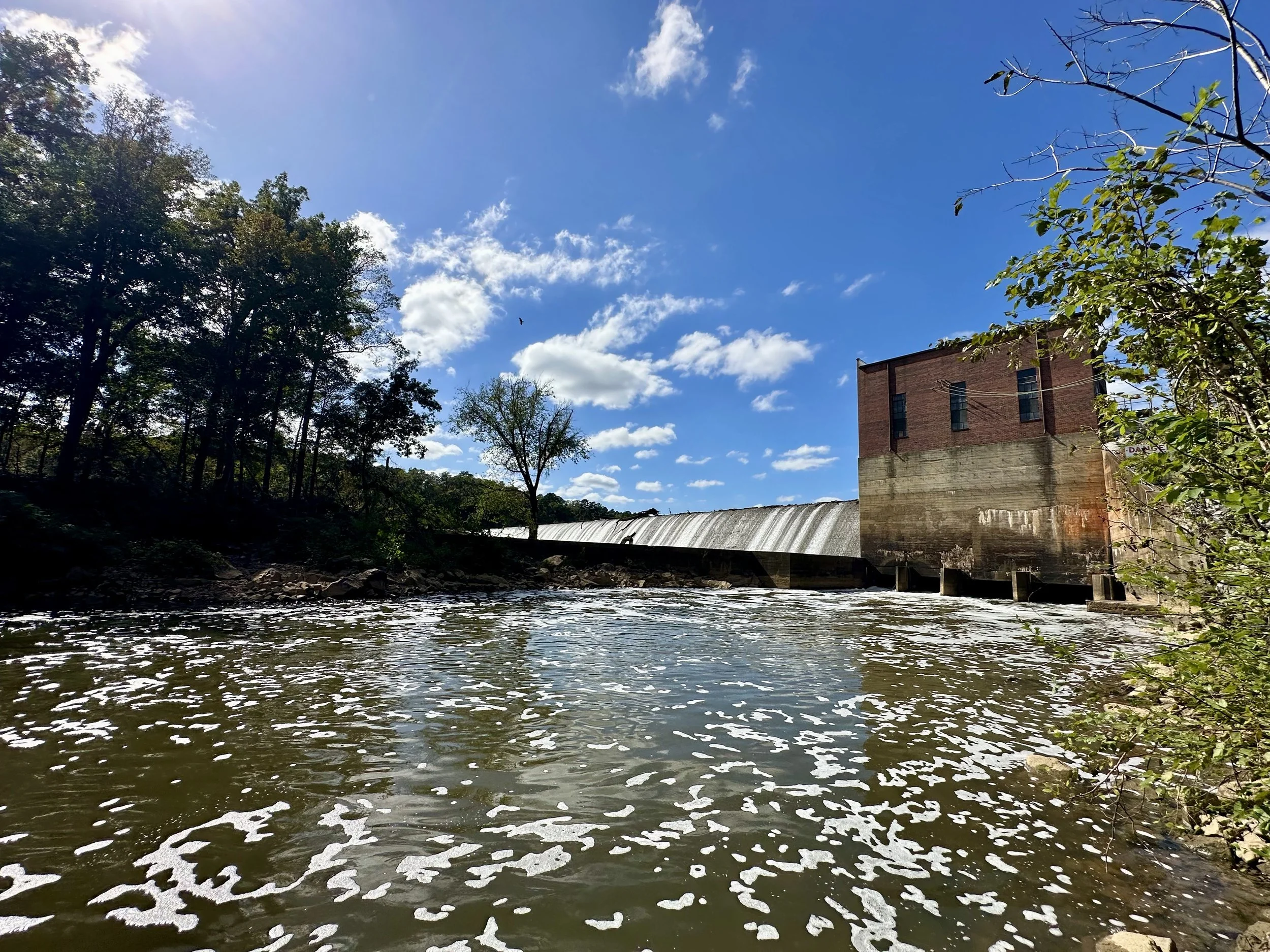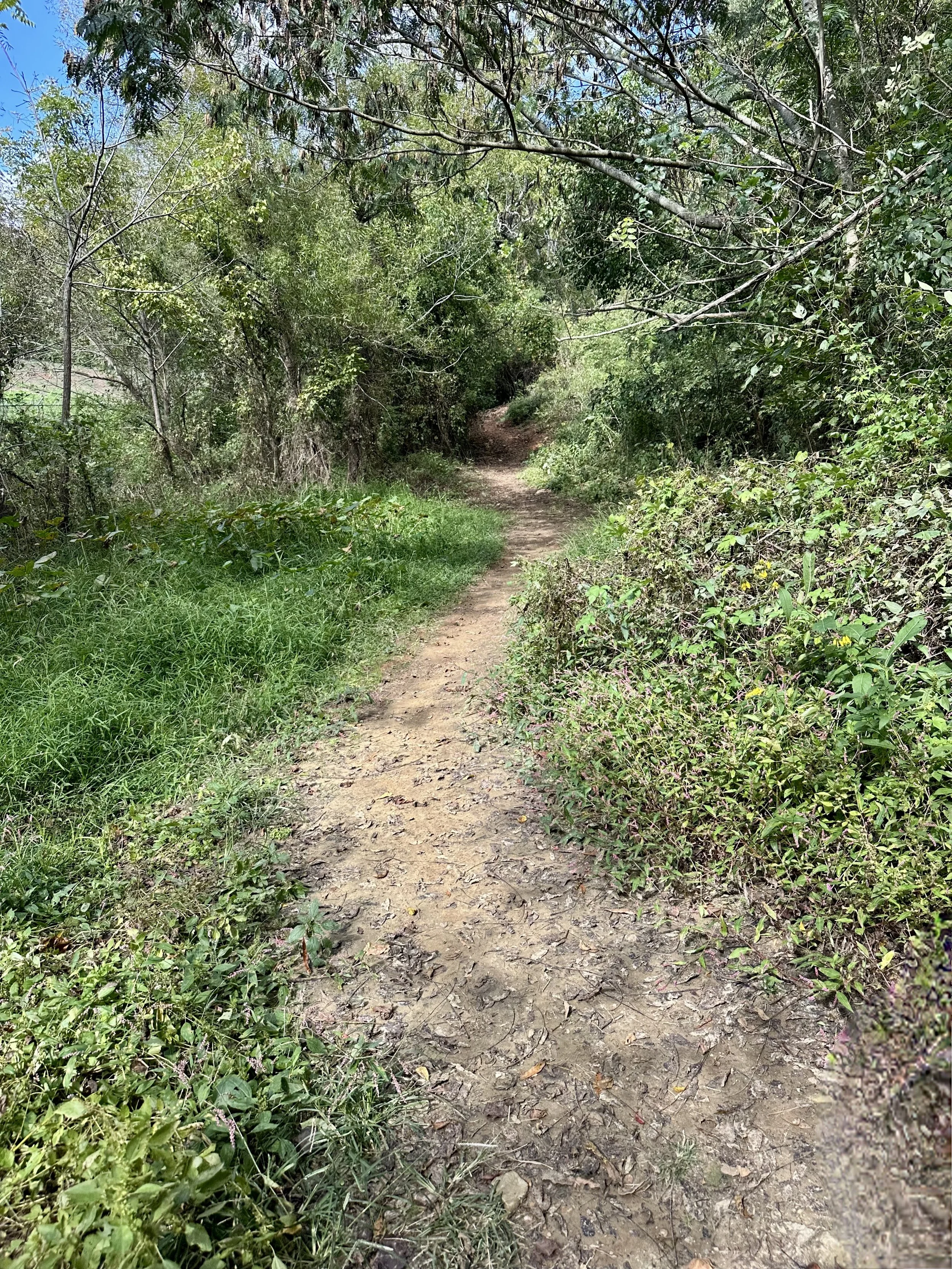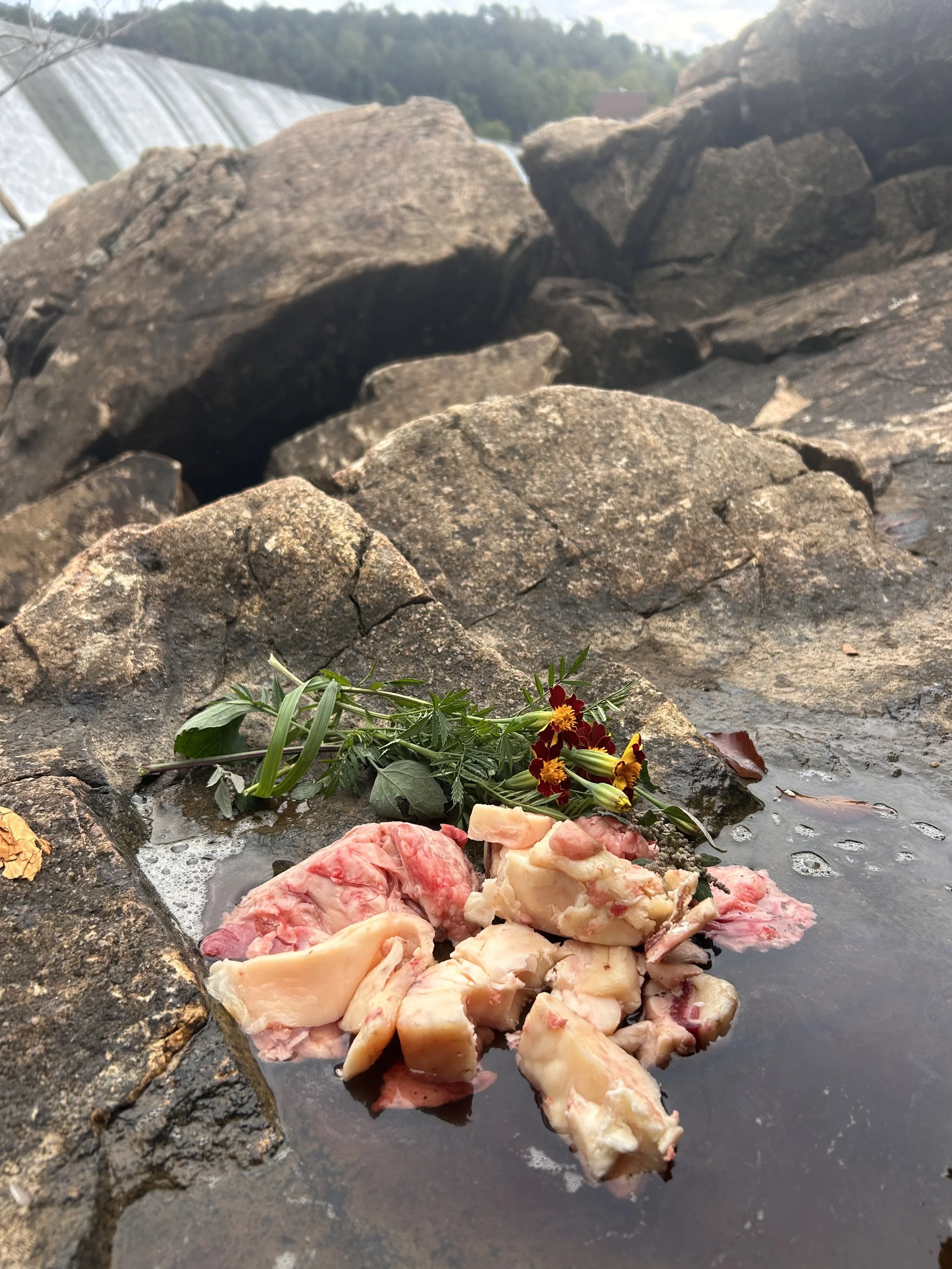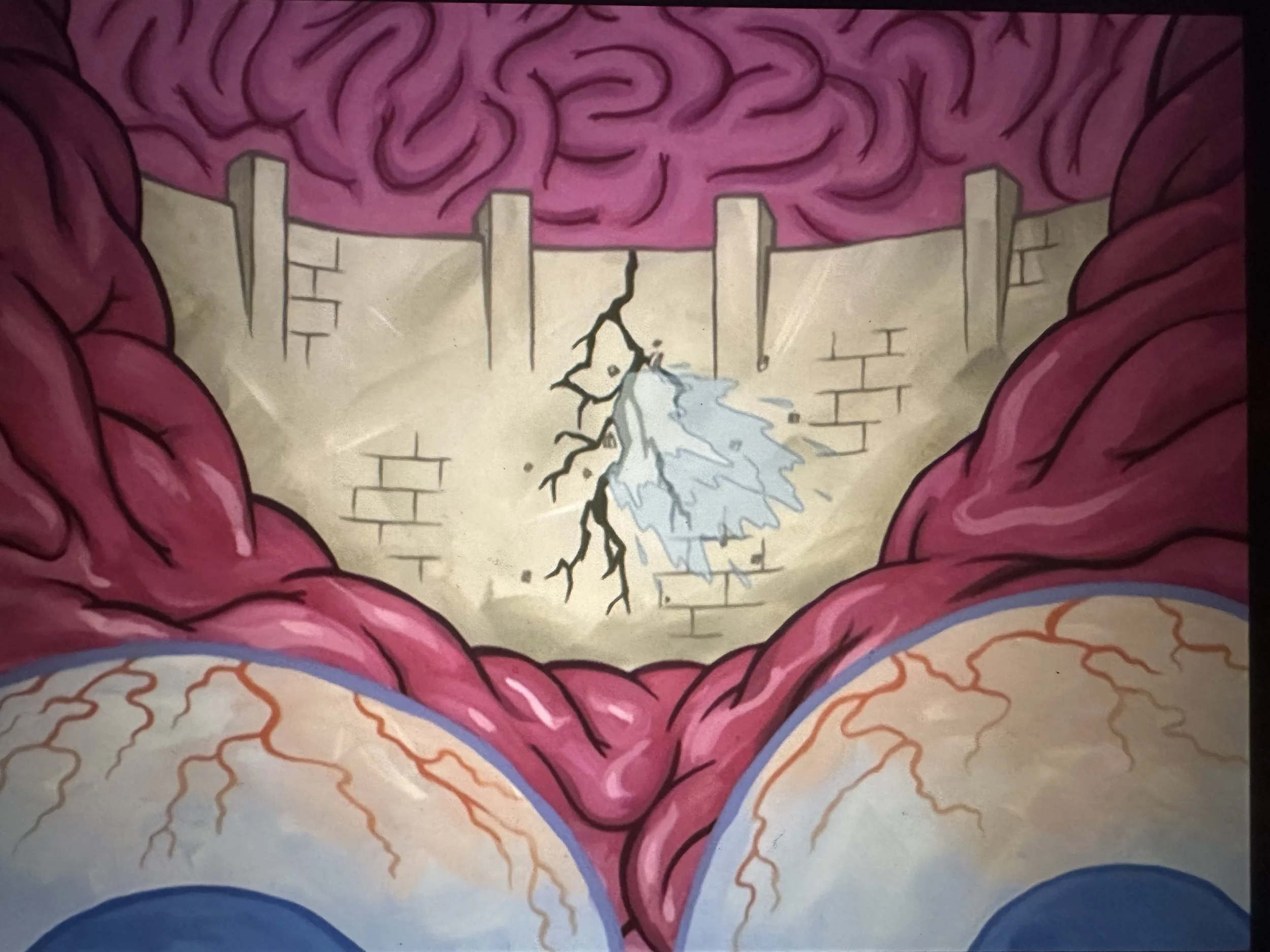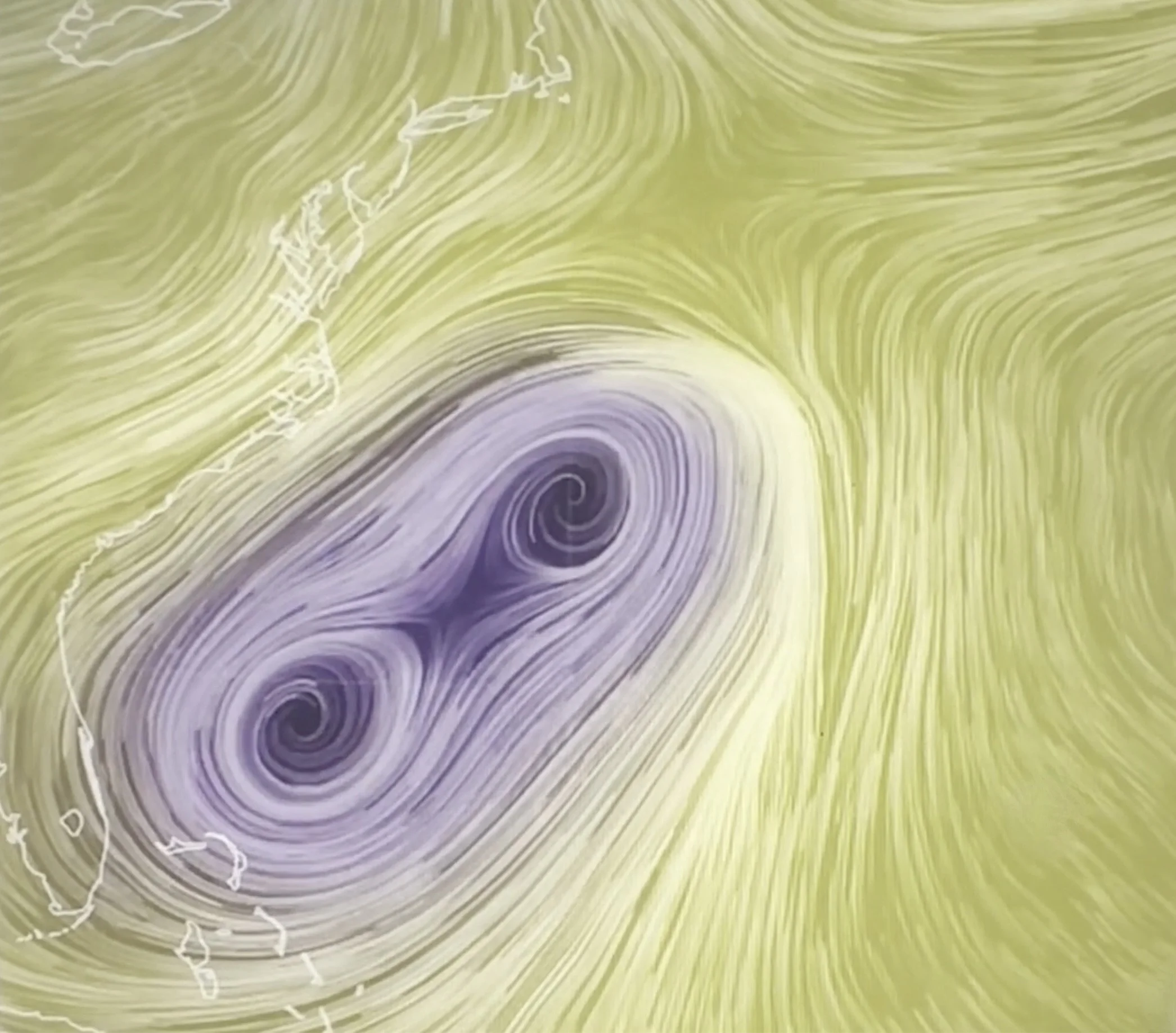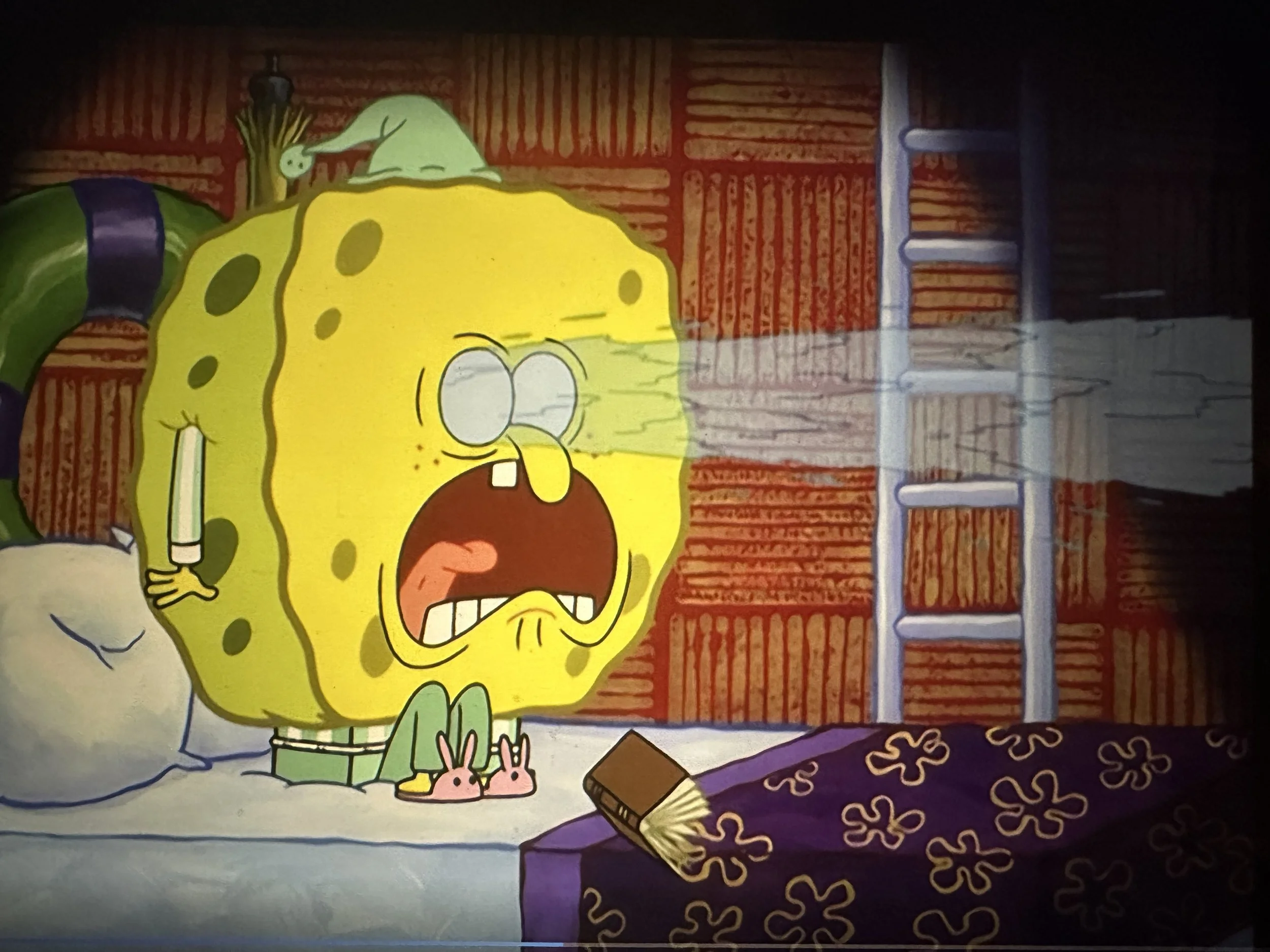Entering the Murmuration
This story has no beginning, but I’ll start with the Hawk.
In the middle of the solar eclipse on September 21, 2025, the Hawk gave her alarm call. The first time I heard this call happened on July 6, the day Saxapahaw and Chapel Hill, land of the Yésah, catastrophically flooded. Human beings hadn’t seen it coming, but Hawk did. People lost everything—cars, homes, businesses, loved ones. The Red-Shouldered Hawk’s call sounded so distinct that I recorded it, and told my husband an alarm had been sounded.
Although the alarm carries other layers of perfectly commonplace correspondences, it emitted a unique urgency that distinguished it from the many calls I’d heard from my familiar friend. As she had in July, she called directly above the gazebo, the ceremonial hub of my land. A familiar clarity overcame me, registering her call as an alarm.
the fire circle | photo by Erin Langley | Image shows a blurred group of European-descended people gathered around a fire at night.
We were due to have our local gathering that night. A growing group of listening people share food and stories around a fire every new moon. I knew right away Hawk had enlisted me to share her message. We pass around an object—usually a large stone, but sometimes a walrus tusk, sometimes a whale vertebra—and take turns speaking. Almost as soon as the stone came to me, I disappeared into Hawk’s message.
“Become love like a dagger, immovable in the midst of escalating chaos.” I felt like a clean, hollow bone, sounding Hawk’s clarion call to remain in touch with what is real. Enter the softness of our animal bodies, hearts, instincts, and dreams. Nourish our closest connections with family, community, and land. Listen for the clear and subtle directives of nature, always expressing our indestructible togetherness.
Image shows a text message of a weather forecast including an image of a possible hurricane moving toward the Southeastern United States
A few days later, my husband texted a hurricane forecast for North Carolina. Exactly one year after Helene’s devastation of Asheville and ten surrounding counties, another storm was approaching. I visited my friend and neighbor Meg for a massage. Massage is a misnomer for what Meg offers. She creates literal sanctuary, deep and wide as whales, from which messages surface and wholeness finds us. She placed a Heron feather on my belly and offerings in my hands. She and her family founded a community farm dedicated to restoring balance between Earth and people.
Meg is one reason I can write this story. She has spent her whole life stewarding this land and community. The relationships she has tended through incredible effort over decades offer stability and natural protection that directly benefit me, and all of us. A nearby mountain orchestrated the unfolding alliance between our families to re-establish continuity with the land. We live less than a mile apart.
inside the sanctuary | photo by Meg Toben | Image shows a woman of European descent lying face up on a massage table holding butter and honey, with a Heron feather on her lower abdomen. Sprigs of foliage frame her face.
Meg also founded the monthly fire circles. Because everyone in the circle carries European ancestry, we decided to focus on remembering the European Indigenous Mind. Though we haven’t formally begun this work, it’s always happening in the background. Organically, we move toward our origins, as concepts that impede our belonging resolve. I have been explicitly unmasking my indigenous mind for twenty years, and facilitating this work for fifteen. If this sounds like I have changed something about my own mind, it really means I have rejoined nature, or opened into a continuous state of divination. To be fully alive is to touch everything. Belonging to our own people and to the lands that now hold us honors our ancestors as well as the tribes who have tended place for millennia.
Back in my car, still in an altered state, I heard the word “propitiate.” I recognized it instantly as an instruction. As I tuned in more, I heard, “Propitiate the weather.” Tenfour, I replied, likely out loud, as I hurried home to ask my husband what propitiate meant. He told me in his own words, and we looked it up to make sure. To propitiate means to make offerings that restore right relationship. The word is related to propitious, meaning "likely to have or produce good results" or "being a good omen."
I called my friend Steckley right away. She’s my teammate in Earth-listening, who invited me to the monthly fire circles six months ago. Although I’d become extremely comfortable spending all my time away from people, I said yes to Steckley’s invitation because I respect her so much. She’s a protector of water, children, and all of life, and she keeps her formidable power on the down-low. Steckley is incognito; people do not detect her relentless ferocity, dedication, and expertise. She is an unstoppable force of love, like water itself. My late teacher Liu Ming used to say that the most skillful people have tremendous impact without anyone’s noticing.
Though we had no plans to talk, she’d been waiting on my call. I gave her the word on the street—we’d been enlisted to propitiate the weather! She already knew this, of course. Steckley and I didn’t know specifically what propitiating would like or when it would happen, but we readied our offerings. We decided to go with the flow of our days, already replete with childcare, homemaking, and professional responsibilities. Let things happen when they happen is the tried and true modus operandi of the indigenous mind.
the fairy mound | photo by Erin Langley | Image shows a tree stump with a small red door in a wooded area on a sunny day. The stump is surrounded by a mound of moss of different shades of green and purple, with green moss on top.
That afternoon, I got the house in order, cooked dinner, and put offerings of butter at the well, the stone circle, and the fairy mound. It felt like setting the stage, making sure that my closest relationships—starting with myself—felt nourished. I didn’t want to bypass my inner circle and go straight to the weather. That is self-and-other. That is speaking to the manager. I performed this gesture to harmonize intent, creating cohesion between “inner” and “outer”—a distinction both useful and fabricated. We are the weather. We needed to move as one.
Around the fire, Steckley offered a brilliant analogy. In a murmuration of starlings, each bird pays attention only to the six birds surrounding it. By attending only to its inner circle, the whole swell moves as one. Propitiation is not weather control, but attunement and direction from within the system. Propitiation is orchestrated love.
Watercolor paintings by Leigh Brown | photo by Erin Langley | Image shows a rotating display rack of small watercolor paintings of nature scenes and blue and purple organic compositions.
Now it was time to pick up my son Tenzin from school. Most days, we hang out at the playground, a forested haven of intergenerational and interspecies play. I’ve made friends there with Sue, a dear elder who watches her granddaughter in the afternoons. I love Sue, and for some reason I just knew that I needed to bring her an offering today. It also felt like more than that. Sue has a strong connection with the Great Blue Heron, who guides and guards the Haw River and Saxapahaw. It felt like I was being called to make an offering to the Heron, while honoring Sue as an elder.
I popped into the local artists’ studio and picked up two beautiful stones and a small heron painting by a local artist. I brought them to Sue on the playground. Looking back, I understand this was propitiation, too. After we visited a while longer, Tenzin and I got in the car to leave. Only we couldn’t. Instead of turning right like I usually do, I had to turn left. Outraged, Tenzin asked, “Where are we going?”
I went back a different day to take a picture of the dock that called me to the Haw. | photo by Erin Langley | Image shows a sunny day on the shore of a river with a dock emerging from the left side of the frame. Shade dapples the tan, sandy riverbank, with shoreline foliage on the right and dark trees on the far side of the river.
The dock was calling. A nearby place where kayaks enter the Haw pulled us toward it. It reminded me of being in Ireland, where the land fully animates my movements. I told Tenzin we needed to go to the dock. He’d never been there before, but protested loudly and repeatedly. Everything was in its place. “But why do we have to go” he complained. “I don’t know,” I told him, “I think it has something to do with a Heron.” He is used to my cryptic way in the world, and has begrudgingly gone on many adventures with me because of it.
Photo by Diego Madrigal, shared with permission from the artist. | Image shows a great blue heron standing on driftwood at the edge of calm water, its gray feathers against a backdrop of green water and foliage.
We pulled up to the dock, where we found a very kind man fishing and looking after two children while their parents finished their workdays. I discreetly sprinkled tobacco on the bank, thanking the place for calling us over, thanking the Sissapahaw and Occoneechee for tending these banks for generations. Tenzin settled immediately at the sight of kids playing. A girl made a seesaw out of a log and a board, while her brother hand-dug fish traps at the water’s edge. The man had been coming here for 25 years. He told us all about the land and river. It felt like meeting a guide. We watched a Heron glide low over the Haw and catch a fish. Then the man told us, “there’s a trail to the dam right down there,” and he pointed.
I went back a different day to take a picture of the dam. | photo by Erin Langley | Image shows a wide dark greenish-brown river with white sudsy bubbles on top from the water that has moved over the dam in the background. To the right of the dam is a large, square brick building. To the left are shadowed trees on the far side of the river.
Now eager to participate, Tenzin and I found our way down to the dam. The recent flood has profoundly impacted the forested shoreline, which wants only very deliberate human participation. We walked carefully and kindly to the river. One of us did. Tenzin did his thing, which was the right thing, too. The land asked us to take nothing, not even pictures. My Oneida/Frank elder Dr. Apela Colorado taught me to document everything for record-keeping and storytelling. Once we enter our indigenous minds, synchronicity becomes a lifestyle. I have heeded her advice to a fault, but she also taught me to listen. Today, we could only take trash that had been washed up by the flood.
the trail back | photo by Erin Langley | Image shows a clay-colored footpath winding through lime-green foliage.
As soon as I saw the dam, I understood that we had entered the time and place of propitiation. I offered tobacco and sang a protective lullaby in Irish. Then I disappeared into the murmuration. My son always calms down when oracle mode takes over. Clear, good words flowed with the river and the wind. After a few minutes, they delivered me back to shore. Tenzin chucked hickory nuts on the way back to the car. The air felt thick and smelled good. I gathered it like honey with outstretched arms along the trail. I asked Tenzin if he noticed a change in the air, and he said yes.
We could see the other side of the dam from where we’d been sitting, and Tenzin really wanted to get there. We drove a ways and got out at the nearest trailhead, which was closed. We put down some tobacco requested permission to enter anyway. I asked Tenzin what he noticed. “Nothing,” he told me. Protocol bores him. A gentle breeze invited us toward the trail. I felt moved that the land let us in. In general, it just wants to rest. Debris obstructed our way to the other side of the dam, so we couldn’t get there. Instead, I sang another Irish lullaby, and we hauled out a sizable mound of trash. As we exited the trail, a bald eagle flew over. I asked Tenzin how he would “read” that. He pretended to not understand what I meant, but knew the Eagle was a good sign.
photo by Steckley Lee | Image shows Steckley’s offerings—large chunks of pink and peace fish and red and orange flowers at the base of a rock on the Haw River. White water crests the dam in the upper lefthand corner.
We made our way back home, weary from a long, productive day. Just as we walked in the door, I got a text from Steckley that made me forget my fatigue. She’d sent a photo of her offerings—laid out on the far side of the dam. Without knowing it, we had stood on opposite banks, singing and making offerings at the exact same time. I felt awestruck that the land had dreamed us together so strongly in this shared gesture of love. I sent her a very enthusiastic voice memo, detailing the living divination that led me to “my” side of the dam. Later that night, she retold her own revelations and the stories that brought her to the opposite shore. I learned so much from her journey, and am eager for her to share more.
Although bedtime was near, I felt excited now, not quite ready to wind down. I’d been in the “thrall” all day. Nonhuman clarity seizes me, and lets me know that I’m “on duty.” It hadn’t released me yet, even after the river propitiation. I felt the storm coming, and understood I’d be greeting the lightning later that night. This quietly thrilled me, but my energy started to wane. Around 10:30, I thought that maybe I should just go to sleep. As soon as I got into bed, the first peal of thunder arrived. I laughed out loud and put my clothes back on. From the outside, venturing into a lightning storm might seem dangerous, but I didn’t do it on a whim. Nested in the murmuration, the storm and I were one.
“Oxus Lady” with bird body. Oxus Culture, Eastern Iran or Central Asia (ca. 2200–1800 BCE). Chlorite, limestone, lapis lazuli. Private collection, UK. | Image shows an ancient relic of a woman’s upper body merging into wide, winglike forms patterned with waves and feathers. She has a long neck, downcast face, and simplified features. The textures are tactile, with ridges, curves, and smooth areas.
Thunder punctuated our prayer of call and response. Tears and lightning flowed in conversational cadence. This went on for a while. Sometimes the storm felt exactly like kittens purring. My elders taught me to keep part of the dream for myself, to use discernment about what to share. But the most important part of the night might have been the tears. Love poured out of my eyes, and I put it back into the Earth. I remember saying, “we remember, we remember, we remember.”
At last, I was released. The grip of propitiation relented, and kindly sent me to bed. I didn’t sleep much afterward. The subsequent days are typically difficult. Outside traditional societies, propitiants rarely have access to the resources that arise naturally within indigenous communities or even small pockets of listening people. I won’t speak for all unaffiliated dreamers, but I have learned a lot the hard way.
Dissonance shows me what’s missing. I felt profound agitation while trying to have casual social interactions the next day. Oracular tenacity had not yet softened back into the human being. My eyes felt like lasers, and my arms like swords, too ready to cut through delusions that did not belong to me. Exhaustion begets dogma that robs people of their realities, and obstructs the ripening of their own revelations. Stepping out of sync exposed my own inability to relax into the waking dream. All of this showed me the importance of dispelling ritual charge.
I felt insulted and hurt when my husband did not make me breakfast the next morning. Obviously, I do not expect him to make me breakfast every day (although he often does because he’s the best). Registering the energetic lurch simply highlighted the need to be nourished and held. Celebration naturally follows ceremony. Without community scaffolding and land-sanctioned protocol in place, the propitiant likely becomes ill, as I did. It’s not personal—it’s a matter of balance. Understanding this, Tenzin and I brought Steckley some gifts. Being with a fellow propitiant felt good, but I could see that she was as overextended as I was.
Still from SpongeBob SquarePants, “A Day Without Tears” (Nickelodeon, 2010). © 2010 Viacom / United Plankton Pictures. | Image shows a close-up of a dam cracking inside of Spongebob’s exposed brain, with half of his giant, protruding veiny eyeballs showing beneath.
Global wind map from Earth Nullschool shows hurricanes Imelda and Humberto spinning over the Atlantic ocean in a figure eight.
I bushwhacked my way through the next couple of days, wrestling the gap between where we are and where we’re going. Tenzin asked if I would watch Spongebob with him, which sounded like the perfect speed. The first scene showed a dam breaking behind SpongeBob’s eyes, as he tried not to cry. I understood right away that flooding is unexpressed grief. Externalized tears become hurricanes, and huge whirlwinds of devastation perfectly mirror our collective behavior. Just as our everyday choices regulate the weather, so do our tears.
The dam perfectly symbolizes interrupted flow—not only of grief, but of life. Human beings are the flow of space and time. Flow is our birthright. Darren texted me the new weather forecast. A second storm had formed. Now two hurricanes swirled in graceful formation, dancing each other back toward their Atlantic origins.
Still from SpongeBob SquarePants, “A Day Without Tears” (Nickelodeon, 2010). © 2010 Viacom / United Plankton Pictures. | Image shows SpongeBob projectile crying from his bed with a silver ladder and a buoy against a red wall in the background.
Crying is a form of water sovereignty. Realizing this made me feel immediately better about all the crying I do. Life is so beautiful that it often just comes out my eyes. Other times, the horrors of Earth get lodged in my body, and ride my tears back out. Sometimes I cry because I am just so tired. Often, I don’t know why I’m crying—only that it’s good, or at least necessary. Letting tears flow acknowledges water’s right to move where and when it wants to.
Once we rejoin nature, we remember that we have always been the weather. Listening bodies and bleeding bodies constantly propitiate, composting war and grief, and changing the course of storms without our even knowing. As more of us remember, we relieve the significant burden that our collective misconduct places on frontline bodies like mine.
We will never know how Steckley and I—and countless unseen propitiants—affected the path of this particular storm, nor do we need to. This story is about following the Hawk, the Heron, and the Haw. It’s about how storms move, and starlings. It’s about remembering that six birds shape the whole system. I don’t conflate poetry with tidiness or ease. Entering the murmuration is extremely hardcore. Surrendering to the living flow requires complete energetic honesty and ever-deepening integrity with nature. We may be moved in ways that seem mysterious from the outside. But inside the murmuration, belonging awaits. We need only relax into place, and let ourselves be carried home.

